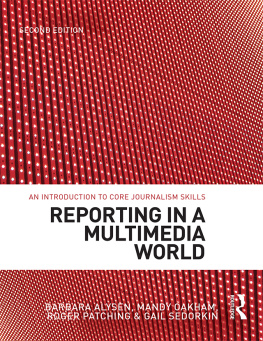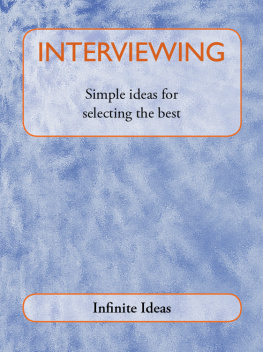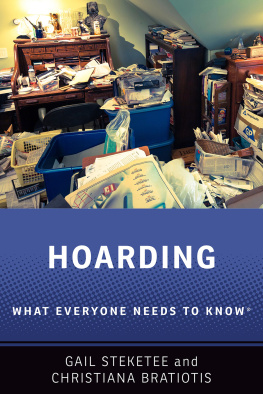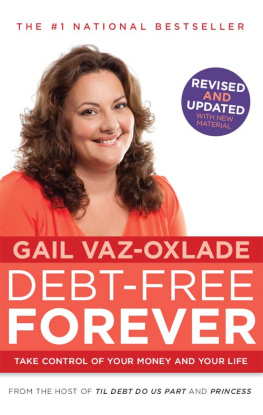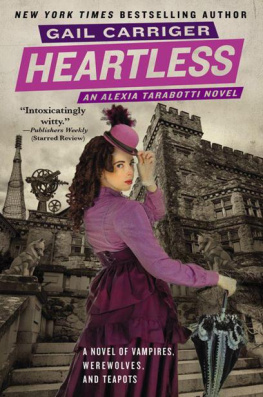Gail Sedorkin - Interviewing
Here you can read online Gail Sedorkin - Interviewing full text of the book (entire story) in english for free. Download pdf and epub, get meaning, cover and reviews about this ebook. year: 2011, publisher: Taylor and Francis, genre: Home and family. Description of the work, (preface) as well as reviews are available. Best literature library LitArk.com created for fans of good reading and offers a wide selection of genres:
Romance novel
Science fiction
Adventure
Detective
Science
History
Home and family
Prose
Art
Politics
Computer
Non-fiction
Religion
Business
Children
Humor
Choose a favorite category and find really read worthwhile books. Enjoy immersion in the world of imagination, feel the emotions of the characters or learn something new for yourself, make an fascinating discovery.
- Book:Interviewing
- Author:
- Publisher:Taylor and Francis
- Genre:
- Year:2011
- Rating:3 / 5
- Favourites:Add to favourites
- Your mark:
- 60
- 1
- 2
- 3
- 4
- 5
Interviewing: summary, description and annotation
We offer to read an annotation, description, summary or preface (depends on what the author of the book "Interviewing" wrote himself). If you haven't found the necessary information about the book — write in the comments, we will try to find it.
Interviewing — read online for free the complete book (whole text) full work
Below is the text of the book, divided by pages. System saving the place of the last page read, allows you to conveniently read the book "Interviewing" online for free, without having to search again every time where you left off. Put a bookmark, and you can go to the page where you finished reading at any time.
Font size:
Interval:
Bookmark:

interviewing
Gail Sedorkin
2ND EDITION
A guide for journalists and writers

First published 2002 by Allen & Unwin
Published 2020 by Routledge
2 Park Square, Milton Park, Abingdon, Oxon OX14 4RN
605 Third Avenue, New York, NY 10017
Routledge is an imprint of the Taylor & Francis Group, an informa business
The author acknowledges the contribution of Judy McGregor to the first edition of this book, some of which has been retained or adapted in this new edition.
Copyright Gail Sedorkin 2011
All rights reserved. No part of this book may be reprinted or reproduced or utilised in any form or by any electronic, mechanical, or other means, now known or hereafter invented, including photocopying and recording, or in any information storage or retrieval system, without permission in writing from the publishers.
Notice:
Product or corporate names may be trademarks or registered trademarks, and are used only for identification and explanation without intent to infringe.
Cataloguing-in-Publication details are available from the National Library of Australia
www.trove.nla.gov.au
Set in 10.5/13 pt Garamond by Midland Typesetters, Australia
ISBN-13: 9781742370941 (pbk)
For Lisa
My first thanks must go to my sister Lisa, who contributed to the content of this edition, and also researched, proofed, supported and encouraged me, together with my husband Nick, my mother and father, Mollie and Lou Svanetti, brother Andrew and sister-in-law Ada. The support and encouragement of friends and colleagues Barbara Alysen and Mandy Oakham was also invaluable.
For their time and expertise I would like to thank Ian Baker, Janie Barton, Peter Bennetts, Craig Borrow, Andrea Carson, Channel 7, Peter Davis, Jon Faine, Liz Gray, John Hamilton, Beth Harvey, the Herald Sun, Sharon Hill, Dorothy Horsfield, Louise Keller, the late Paul Lyneham, Jodie Munro OBrien, Network Nine, Kerry OBrien, Robert Reid, SBS Publicity and Andrew Urban.
And, of course, at Allen & Unwin, Elizabeth Weiss, who kept the project going, and Jo Lyons for her meticulous editing, attention to detail, patience and support.
Gail Sedorkin
Almost every journalist has a horror story or two to tell about their first interviewing attemptsfailing to ask questions, not listening to the answers, having a recording with no sound, or returning to the newsroom practically empty-handed are common disasters.
David Leser says that his first interview twenty-two years ago, when he was working for The Daily Telegraph as a cadet journalist, is still etched in his brain.
It was my first day on the job and there was an industrial dispute and I had to call management and workers to get a response. This was my very first call for my very first story and I was so nervous that, when the person answered the phone, I promptly forgot not only whom I was calling but why I was calling (2001: 8).
Cadets interview training often consisted of watching a senior reporter for a few days before being let loose to sink or swim, despite the fact that interviewing is an integral part of journalism and professional writing. In fact, Ken Metzler believes that good reporting is about 80 per cent interviewing, and goes on to ask, What is the point of being a good writer if you have nothing of substance to convey through your writing? (1977: 133).
Bob Jervis agrees that interviewing is the most important, and the most difficult, skill of the journalist. It takes the average cadet... about eight weeks to become a reasonably adept intro-writer; about a year to learn to structure a fairly complicated news story passably; and much, much longer to become a competent interviewer (1989: 96).
Theres no more daunting prospect than having to meet with a total stranger for the sole purpose of eliciting information from them on a topic you know little to nothing about. Interviewing ranks on the stress levels right up there with giving a one-hour speech to a crowded room but, as with giving a speech, there are three keys to success:
- preparation
- preparation, and
- preparation.
Masterton and Patching sum it up in just one line: In every case the best interviews are those that are best prepared, with the best questions in the best sequence, and where the reporter listens carefully to every word of every answer (1997: 202).
This is the main point I am making in this book, and it is stressed again and again in the tips, checklists and advice provided by some of the best interviewers from around the world. Cadets, trainees and students were also canvassed about their major fears, and I hope that they will find answers to their questions in these pages.
Organise your contact book (which will quickly become your bible), let my research tips guide your own digging, adapt my questions to your topic and incorporate my step-by-step guide to each and every interview you conduct. Following the best practice guidelines in this book will allow any writer to craft superior stories from quality interviews.
To make the most of your interviews, however, enjoy the incredible opportunity you have to talk to so many interesting people!
- Jervis, B. 1989, News Sense, Advertiser Newspapers Limited, Adelaide, SA
- Leser, D. 2001, The interview: art or a confidence trick? The Walkley Magazine, issue 13, p. 8
- Masterton, M. and Patching, R. 1997, Now the News in Detail, Deakin University Press, Geelong, Vic
- Metzler, K. 1977, Creative Interviewing: The Writers Guide to Gathering Information by Asking Questions, Prentice-Hall, New Jersey, USA
Karl Stefanovic: Are you a monster?
Anne Hamilton-Byrne: I'm not conscious of what you're saying, I should be conscious of.
Karl Stefanovic: Are you a monster?
Anne Hamilton-Byrne: Certainly not.
Karl Stefanovic: Are you evil?
Anne Hamilton-Byrne: Well, what do you call evil?
Karl Stefanovic: The systematic abuse of children is evil.
Anne Hamilton-Byrne: No.
(Excerpt from 60 Minutes, Channel 9 2009)
If the purpose of this exchange was dramatic television then it could certainly be seen as a successful interview. If, however, the aim was, as for most journalistic interviews, to illicit information and insights (Brady 2004: 1), very little was achieved in this clash. The interview was conducted by Karl Stefanovic for 60 Minutes, questioning alleged cult leader and child abuser Anne Hamilton-Byrne.
Today interviews, particularly those broadcast on television, can attract very large audiences. But what is an interview? Is it a conversation between two people or an exchange in which one person challenges the other, a way of tricking people into revealing facts or an argument in which two opponents are pitted against each other? Is it an opportunity for the interviewee to give a speech, or is a journalist merely a conduit for channelling information from the source to the public? It could easily be argued that interviewing is all of these, and more.
Journalism educator and publishing consultant Professor John Brady states that interviewing is a little bit like going on a blind date. Its basically a process of getting to know someone by asking questions and getting answers. In many ways, this is something weve been doing all our lives, and it is usually a very comfortable process. (Brady 2004: 1).
Font size:
Interval:
Bookmark:
Similar books «Interviewing»
Look at similar books to Interviewing. We have selected literature similar in name and meaning in the hope of providing readers with more options to find new, interesting, not yet read works.
Discussion, reviews of the book Interviewing and just readers' own opinions. Leave your comments, write what you think about the work, its meaning or the main characters. Specify what exactly you liked and what you didn't like, and why you think so.


